-
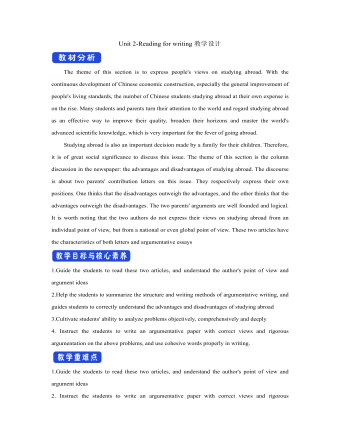
新人教版高中英语选修2Unit 2 Reading for writing教学设计
The theme of this section is to express people's views on studying abroad. With the continuous development of Chinese economic construction, especially the general improvement of people's living standards, the number of Chinese students studying abroad at their own expense is on the rise. Many students and parents turn their attention to the world and regard studying abroad as an effective way to improve their quality, broaden their horizons and master the world's advanced scientific knowledge, which is very important for the fever of going abroad. Studying abroad is also an important decision made by a family for their children. Therefore, it is of great social significance to discuss this issue. The theme of this section is the column discussion in the newspaper: the advantages and disadvantages of studying abroad. The discourse is about two parents' contribution letters on this issue. They respectively express their own positions. One thinks that the disadvantages outweigh the advantages, and the other thinks that the advantages outweigh the disadvantages. The two parents' arguments are well founded and logical. It is worth noting that the two authors do not express their views on studying abroad from an individual point of view, but from a national or even global point of view. These two articles have the characteristics of both letters and argumentative essays1.Guide the students to read these two articles, and understand the author's point of view and argument ideas2.Help the students to summarize the structure and writing methods of argumentative writing, and guides students to correctly understand the advantages and disadvantages of studying abroad3.Cultivate students' ability to analyze problems objectively, comprehensively and deeply
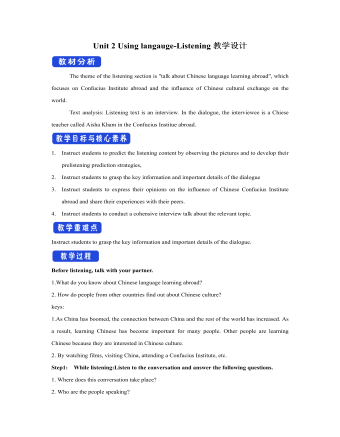
新人教版高中英语选修2Unit 2 Using langauge-Listening教学设计
? B: Absolutely! Getting involved with Chinese cultural activities there definitely helped a lot. I got to practice my Chinese on a daily basis, and I could learn how native Chinese speakers spoke.? A: What do you feel is your biggest achievement?? B: Learning Chinese characters! I have learnt about 1,500 so far. When I first started, I didn't think it was even going to be possible to learn so many, but now I find that I can read signs, menus, and even some easy newspaper articles.? A: What are you most keen on?? B: I've really become keen on learning more about the Chinese culture, in particular Chinese calligraphy. As I have learnt Chinese characters, I have developed a great appreciation for their meaning. I want to explore Chinese characters by learning how to write them in a more beautiful way. ? A: Finally, what do you want to say to anyone interested in learning Chinese?? I have really become keen on learning more about the Chinese culture, in particular Chinese Calligraphy. As I have learnt Chinese character, I have developed a great appreciation for their meaning. I want to explore Chinese characters by learning how to write them in a more beautiful way.? A: Finally, what do you want to say to anyone interested in learning Chinese?? B: I'd say, give it a shot! While some aspects may be difficult, it is quite rewarding and you will be happy that you tried.? A: Thanks for your time. ? B:You're welcome.

新人教版高中英语选修2Unit 3 Using langauge-Listening教学设计
1. How is Hunan cuisine somewhat different from Sichuan cuisine?The heat in Sichuan cuisine comes from chilies and Sichuan peppercorns. Human cuisine is often hotter and the heat comes from just chilies.2.What are the reasons why Hunan people like spicy food?Because they are a bold people. But many Chinese people think that hot food helps them overcome the effects of rainy or wet weather.3.Why do so many people love steamed fish head covered with chilies?People love it because the meat is quite tender and there are very few small bones.4.Why does Tingting recommend bridge tofu instead of dry pot duck with golden buns?Because bridge tofu has a lighter taste.5 .Why is red braised pork the most famous dish?Because Chairman Mao was from Hunan, and this was his favorite food.Step 5: Instruct students to make a short presentation to the class about your choice. Use the example and useful phrases below to help them.? In groups of three, discuss what types of restaurant you would like to take a foreign visitor to, and why. Then take turns role-playing taking your foreign guest to the restaurant you have chosen. One of you should act as the foreign guest, one as the Chinese host, and one as the waiter or waitress. You may start like this:? EXAMPLE? A: I really love spicy food, so what dish would you recommend?? B: I suggest Mapo tofu.? A: Really ? what's that?

新人教版高中英语选修2Unit 4 Learning about Language教学设计
This section guides students to pay attention to the typical context of vocabulary use, helps students accumulate vocabulary around the key vocabulary of this unit, and uses the learned words and word chunks in different contexts to deeply understand their meaning and usage, so as to achieve the purpose of review and consolidation.The teaching design activities aim to guide students to pay attention to the typical context in which the target vocabulary is used, as well as the common vocabulary used in collocation, so that students can complete the sentence with correct words. In terms of vocabulary learning strategies, this unit focuses on cultivating students' ability to pay attention to collocation of words and to use word blocks to express meaning.For vocabulary learning, it is not enough just to know the meaning of a single word, but the most important thing is to master the common collocations of words, namely word blocks.Teachers should timely guide students to summarize common vocabulary collocation, such as verb and noun collocation, verb and preposition collocation, preposition and noun collocation, and so on.1. Guide students to understand and consolidate the meaning and usage of the vocabulary in the context, 2. Guide the students to use the unit topic vocabulary in a richer context3. Let the students sort out and accumulate the accumulated vocabulary, establishes the semantic connection between the vocabulary,4. Enable students to understand and master the vocabulary more effectivelyGuiding the Ss to use unit topic words and the sentence patterns in a richer context.

新人教版高中英语选修2Unit 4 Reading for writing教学设计
假定你是英国的Jack,打算来中国旅行,请你给你的中国笔友李华写一封信,要点如下:1.你的旅行计划:北京→泰山→杭州;2.征求建议并询问他是否愿意充当你的导游。注意:1.词数80左右(开头和结尾已给出,不计入总词数);2.可以适当增加细节,以使行文连贯。参考词汇:故宫 the Forbidden City;泰山 Mount TaiDear Li Hua,I'm glad to tell you that 'm going to visit China.First,I am planning to visit Beijing,the capitalof China,where I am looking forward to enjoying the Great Wall,the Forbidden City and somebeautiful parks.Then I intend to go to visit Mount Tai in Shandong Province.I've heard that it is one ofthe most famous mountains in China and I can't wait to enjoy the amazing sunrise there.After that,I amalso going to Hangzhou.It is said that it is a beautiful modern city with breathtaking natural sights,among which the West Lake is a well- known tourist attraction.What do you think of my travel plan? Will you act as my guide? Hope to hear from you soon.

新人教版高中英语选修2Unit 4 Using langauge-Listening教学设计
The theme of the listening section is " talking about scenery and culture along a journey."The part is designed to further lead the students to understand Canadian natural geography and social environment, and integrated into the cultural contrast by mentioning the long train journey from Beijing to Moscow routes. On this basis, the part activates students related travel experience, lets the student serial dialogue, guides the student to explore further the pleasure and meaning of the long journey, and Chinese and foreign cultural comparison.The part also provides a framework for the continuation of the dialogue, which is designed to provide a framework for students to successfully complete their oral expressions, and to incorporate an important trading strategy to end the dialogue naturally.1. Help students to understand and master some common English idioms in the context, and experience the expression effect of English idioms.2. Guide the students to understand the identity of different people in the listening context, and finish the dialogue according to their own experience.3. Instruct the students to use appropriate language to express surprise and curiosity about space and place in the dialogue, and master the oral strategy of ending the dialogue naturally.1. Instruct students to grasp the key information and important details of the dialogue.2. Instruct students to conduct a similar talk on the relevant topic.

新人教版高中英语选修2Unit 5 Learning about Language教学设计
The purpose of this section of vocabulary exercises is to consolidate the key words in the first part of the reading text, let the students write the words according to the English definition, and focus on the detection of the meaning and spelling of the new words. The teaching design includes use English definition to explain words, which is conducive to improving students' interest in vocabulary learning, cultivating their sense of English language and thinking in English, and making students willing to use this method to better grasp the meaning of words, expand their vocabulary, and improve their ability of vocabulary application. Besides, the design offers more context including sentences and short passage for students to practice words flexibly.1. Guide students to understand and consolidate the meaning and usage of the vocabulary in the context, 2. Guide the students to use the unit topic vocabulary in a richer context3. Let the students sort out and accumulate the accumulated vocabulary, establishes the semantic connection between the vocabulary,4. Enable students to understand and master the vocabulary more effectivelyGuiding the Ss to use unit topic words and the sentence patterns in a richer context.Step1: Read the passage about chemical burns and fill in the blanks with the correct forms of the words in the box.

新人教版高中英语选修2Unit 5 Reading and thinking教学设计
The theme of this activity is to learn the first aid knowledge of burns. Burns is common in life, but there are some misunderstandings in manual treatment. This activity provides students with correct first aid methods, so as not to take them for granted in an emergency. This section guides students to analyze the causes of scald and help students avoid such things. From the perspective of text structure and collaborative features, the text is expository. Expository, with explanation as the main way of expression, transmits knowledge and information to readers by analyzing concepts and elaborating examples. This text arranges the information in logical order, clearly presents three parts of the content through the subtitle, accurately describes the causes, types, characteristics and first aid measures of burns, and some paragraphs use topic sentences to summarize the main idea, and the level is very clear.1. Guide students to understand the causes, types, characteristics and first aid methods of burns, through reading2. Enhance students’ ability to deal withburnss and their awareness of burns prevention3. Enable students to improve the ability to judge the types of texts accurately and to master the characteristics and writing techniques of expository texts.Guide students to understand the causes, types, characteristics and first aid methods of burns, through readingStep1: Lead in by discussing the related topic:1. What first-aid techniques do you know of ?CPR; mouth to mouth artificial respiration; the Heimlich Manoeuvre

新人教版高中英语选修2Unit 5 Using langauge-Listening教学设计
The theme of this section is to learn how to make emergency calls. Students should learn how to make emergency calls not only in China, but also in foreign countries in English, so that they can be prepared for future situations outside the home.The emergency telephone number is a vital hotline, which should be the most clear, rapid and effective communication with the acute operator.This section helps students to understand the emergency calls in some countries and the precautions for making emergency calls. Through the study of this section, students can accumulate common expressions and sentence patterns in this context. 1.Help students accumulate emergency telephone numbers in different countries and learn more about first aid2.Guide the students to understand the contents and instructions of the telephone, grasp the characteristics of the emergency telephone and the requirements of the emergency telephone.3.Guide students to understand the first aid instructions of the operators.4.Enable Ss to make simulated emergency calls with their partners in the language they have learned1. Instruct students to grasp the key information and important details of the dialogue.2. Instruct students to conduct a similar talk on the relevant topic.Step1:Look and discuss:Match the pictures below to the medical emergencies, and then discuss the questions in groups.
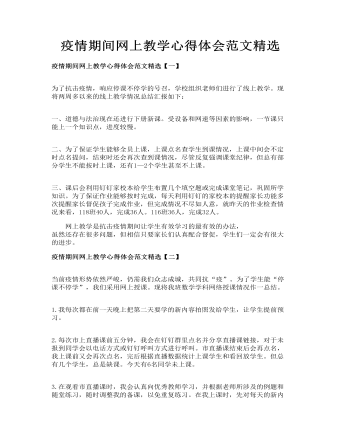
疫情期间网上教学心得体会范文精选
二、为了保证学生能够全员上课,上课点名查学生到课情况,上课中间会不定时点名提问,结束时还会再次查到课情况,尽管反复强调课堂纪律,但总有部分学生不能按时上课,还有1—2个学生甚至不上课。 三、课后会利用钉钉家校本给学生布置几个填空题或完成课堂笔记,巩固所学知识。为了保证作业能够按时完成,每天利用钉钉的家校本的提醒家长功能多次提醒家长督促孩子完成作业,但完成情况不尽如人意,就昨天的作业检查情况来看,118班40人,完成36人。116班36人,完成32人。
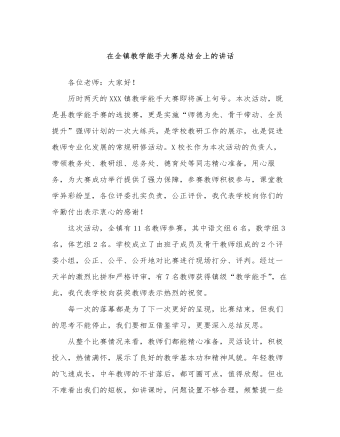
在全镇教学能手大赛总结会上的讲话
三、科学育人抓质量不是只抓课本知识,而是要从抓习惯、抓细节、抓学困生、抓读书等方面入手。抓质量要从培养学生良好的学习习惯入手,良好习惯的培养,只靠班主任一人是心有余而力不足的,需要每一位教师齐心协力,齐抓共管。抓质量要注重细节,如语文要从生字、背诵开始夯实基础,数学要从基本计算、每一个小知识点、读题审题点滴落实。抓好每个细节,进而形成习惯,学生的成绩自然就会提高。抓质量要把目光投向学困生,如课堂上设计一些学困生能够回答上来的问题并及时表扬他们,不断增强自信,课后适当开“小灶”,加强指导,还要跟踪辅导,持续关注,增强他们的学习主动性和积极性,成绩也会有提高。抓质量还要抓读书,要培养学生的读书兴趣,让读书成为学生的生活方式,不仅课上读,还要在课外读,不仅让学生读,教师自己更要读。
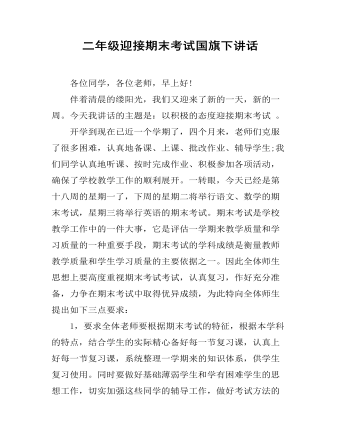
二年级迎接期末考试国旗下讲话
各位同学,各位老师,早上好!伴着清晨的缕阳光,我们又迎来了新的一天,新的一周。今天我讲话的主题是:以积极的态度迎接期末考试 。开学到现在已近一个学期了,四个月来,老师们克服了很多困难,认真地备课、上课、批改作业、辅导学生;我们同学认真地听课、按时完成作业、积极参加各项活动,确保了学校教学工作的顺利展开。一转眼,今天已经是第十八周的星期一了,下周的星期二将举行语文、数学的期末考试,星期三将举行英语的期末考试。期末考试是学校教学工作中的一件大事,它是评估一学期来教学质量和学习质量的一种重要手段,期末考试的学科成绩是衡量教师教学质量和学生学习质量的主要依据之一。因此全体师生思想上要高度重视期末考试考试,认真复习,作好充分准备,力争在期末考试中取得优异成绩,为此特向全体师生提出如下三点要求:1,要求全体老师要根据期末考试的特征,根据本学科的特点,结合学生的实际精心备好每一节复习课,认真上好每一节复习课,系统整理一学期来的知识体系,供学生复习使用。同时要做好基础薄弱学生和学有困难学生的思想工作,切实加强这些同学的辅导工作,做好考试方法的指导工作,激发他们的信心,努力使他们在原有的基础上有所提高。
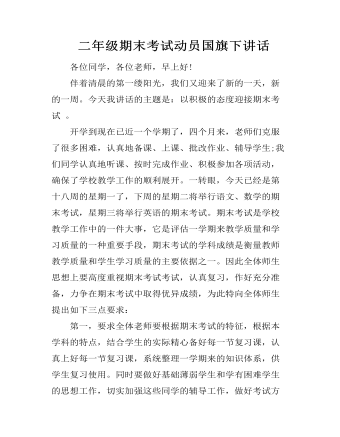
二年级期末考试动员国旗下讲话
各位同学,各位老师,早上好!伴着清晨的第一缕阳光,我们又迎来了新的一天,新的一周。今天我讲话的主题是:以积极的态度迎接期末考试 。开学到现在已近一个学期了,四个月来,老师们克服了很多困难,认真地备课、上课、批改作业、辅导学生;我们同学认真地听课、按时完成作业、积极参加各项活动,确保了学校教学工作的顺利展开。一转眼,今天已经是第十八周的星期一了,下周的星期二将举行语文、数学的期末考试,星期三将举行英语的期末考试。期末考试是学校教学工作中的一件大事,它是评估一学期来教学质量和学习质量的一种重要手段,期末考试的学科成绩是衡量教师教学质量和学生学习质量的主要依据之一。因此全体师生思想上要高度重视期末考试考试,认真复习,作好充分准备,力争在期末考试中取得优异成绩,为此特向全体师生提出如下三点要求:第一,要求全体老师要根据期末考试的特征,根据本学科的特点,结合学生的实际精心备好每一节复习课,认真上好每一节复习课,系统整理一学期来的知识体系,供学生复习使用。

道德与法治七年级下册走进法治天地1作业设计
(一) 单元质量检测内容一、 单项选择题1.小林爸爸承包了村里的一个鱼塘, 需要签订一份承包协议。他爸爸准备去律师 事务所花钱让律师拟订一份承包协议, 他妈妈却说花钱浪费, 自己随便写写就 可以了。这说明( )A.小林妈妈勤俭节约B.小林爸爸小题大做,实属多此一举C.小林爸爸法治观念强,懂得用法律保护自己D.小林父母性格不和,观点有分歧2. 《民法典》规定: 父母对未成年子女负有抚养、教育和保护的义务。《义务教 育法》规定: 社会组织和个人应当为适龄儿童、少年接受义务教育创造良好的 环境。《环境保护法》规定:禁止引进不符合我国环境保护规定要求的技术和 设备。这说明( )A.未成年人的教育问题很重要B.环境保护要求很严格C.生活方方面面都需要法律D.国家重视民生
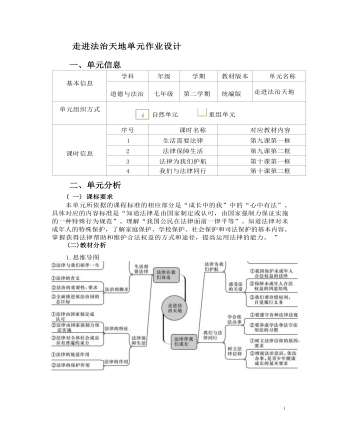
道德与法治七年级下册走进法治天地5作业设计
(四) 作业分析与设计意图作业的素材选择多元化,有漫画、图表等。设问指向明确,注重内容的基础性,应 用性。通过作业设计与实施,可以引导学生关注法律和社会,认识到推进依法治国,建设 社会主义法治国家的意义,增强自己的法律意识和提高依法办事的能力。作业2( 一) 作业内容绘制《与法同行,做守法小公民》手抄报一、活动背景学习了《我们与法律同行》的内容后,同学们充满了力量,更加坚定了建设 社会主义现代化国家的信心。某中学七年级 (1) 班班委会拟组织一次《与法同 行,做守法小公民》手抄报比赛,邀请你参加并绘制一份手抄报。二、活动步骤1.班委会明确活动主题,并对板面设计和内容提出具体要求。 2.学生收集资料,设计版面,组织内容,绘制手抄报。 3.全班交流分享。4.班委会组织评奖,将优秀作品张贴在班级宣传栏展示。
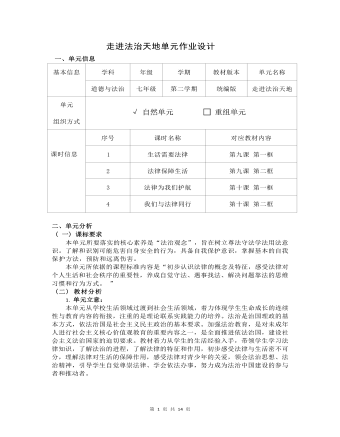
道德与法治七年级下册走进法治天地3作业设计
本单元所要落实的核心素养是“法治观念”,旨在树立尊法守法学法用法意 识。了解和识别可能危害自身安全的行为,具备自我保护意识,掌握基本的自我 保护方法,预防和远离伤害。本单元所依据的课程标准内容是“初步认识法律的概念及特征,感受法律对 个人生活和社会秩序的重要性,养成自觉守法、遇事找法、解决问题靠法的思维 习惯和行为方式。 ”(二) 教材分析1. 单元立意:本单元从学校生活领域过渡到社会生活领域,着力体现学生生命成长的连续 性与教育内容的衔接,注重的是理论联系实践能力的培养。法治是治国理政的基 本方式,依法治国是社会主义民主政治的基本要求。加强法治教育,是对未成年 人进行社会主义核心价值观教育的重要内容之一,是全面推进依法治国,建设社 会主义法治国家的迫切要求。教材着力从学生的生活经验入手,带领学生学习法 律知识,了解法治的进程,了解法律的特征和作用,初步感受法律与生活密不可 分,理解法律对生活的保障作用。
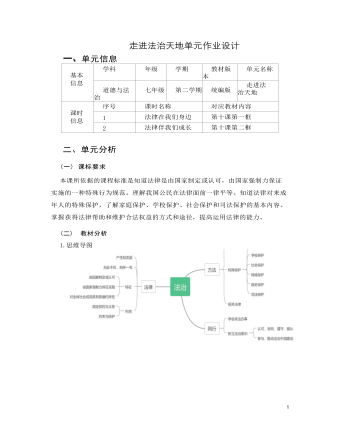
道德与法治七年级下册走进法治天地4作业设计
2.内容内在逻辑本单元作为法律版块的起始单元,以我国建设社会主义法治国家为背景,带 领学生了解社会的法治进程,初步感受法律与生活密不可分,理解法律对生活的 保障作用,感受法律对青少年自身的关爱,引导学生自觉尊崇法律,激发学生学 习法律的责任感,学会依法办事,同时青少年们要积极适应法治时代的要求,树 立法律信仰,努力成为法治中国建设的参与者和推动者。这就需要青少年不断学 习、 内化法律知识,努力为法治中国建设做出自己的贡献。(三) 学情分析未成年人的生理、心理发展都不成熟,辨别是非的能力不强,法制观淡薄,容易受到不良因素的影响,甚至会走上违法犯罪的道路,未成年人违法犯罪 现象是我国面临的一个严峻的社会问题; 受不良社会风气的影响,以及中小学法 治教育需要进一步强化的现状影响,中小学生规则意识和法律意识淡薄。因此, 必须要增强 全民法治观推进法治社会建设,把法治教育纳入国民教育体系,从青 少年抓起,强化规则意识,倡导契约精神,弘扬公序良俗。

道德与法治七年级下册走进法治天地6作业设计
考点:对未成年人实施特殊保护的作用解析:A.B杜绝、不容许、说法太过绝对,排除。 D只看到互联网的消极作用,没 看到互联网的积极作用,排除。故该题应选C。2.答案:C考点:保护未成年人的专门法律解析:A. B说法与题意不符,排除。 D.就不会、太过绝对,排除。《未成年人保 护法》是保护未成年人的专门法律,给予未成年人特殊保护,故该题应选C。3. 答案:B考点:保护未成年人的两部专门法律名称。解析: A.C.D与题意不符,故该题应选B。4. 答案:A考点:学校保护。解析:对学生进行安全教育是学校保护对未成年人特殊保护的表现。 ①②③说法 正确。 ④消除、说法太过绝对,排除。故该题应选A。5. 答案:D考点:未成年人为什么需要特殊保护。解析:①②③④说法正确,故该题应选D。二、 非选择题⑴参考答案:社会保护点拨:从保护的表现和主体判断出是未成年人六道防线中的社会保护。

初中数学浙教版七年级下册《第二章 二元一次方程组 三元一次方程组及其解法》教材教案
知识与技能目标:1. 能正确说出三元一次方程(组)及其解的概念,能正确判别一组数是否是三元一次方程(组)的解;2. 会根据实际问题列出简单的三元一次方程或三元一次方程组。过程与方法目标:1. 通过加深对概念的理解,提高对“元”和“次”的认识。2. 能够逐步培养类比分析和归纳概括的能力,了解辩证统一的思想。情感态度与价值观目标:通过对实际问题的分析,使学生进一步体会方程是刻画现实世界的有效数学模型,培养学生良好的数学应用意识。
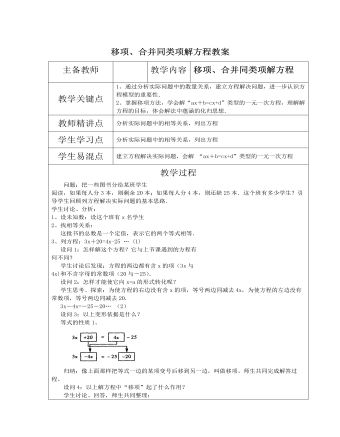
北师大初中七年级数学上册利用移项与合并同类项解一元一次方程教案2
练习:现在你能解答课本85页的习题3.1第6题吗?有一个班的同学去划船,他们算了一下,如果增加一条船,正好每条船坐6人,如果送还了一条船 ,正好每条船坐9人,问这个班共多少同学?小结提问:1、今天你又学会了解方程的哪些方法?有哪些步聚?每一步的依据是什么?2、现在你能回答前面提到的古老的代数书中的“对消”与“还原”是什么意思吗?3、今天讨论的问题中的相等关系又有何共同特点?学生思考后回答、整理:① 解方程的步骤及依据分别是:移项(等式的性质1)合并(分配律)系数化为1(等式的性质2)表示同一量的两个不同式子相等作业:1、 必做题:课本习题2、 选做题:将一块长、宽、高分别为4厘米、2厘米、3厘米的长方体橡皮泥捏成一个底面半径为2厘米的圆柱,它的高是多少?(精确到0.1厘米)







